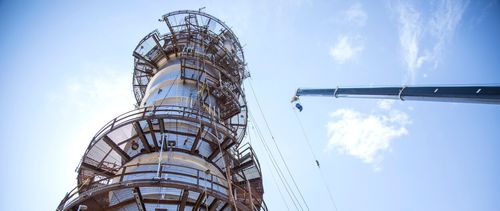Tight deadlines to bring projects online before exemptions expire. No grandfather clause for hourly matching in the US. Differences in carbon intensity measurements. Outstanding questions about geographic matching requirements.
US clean fuels developers eyeing exports to Europe were already facing a complicated regulatory gauntlet to qualify for incentives on both sides of the Atlantic, but it may have just gotten harder.
The European Commission’s recent update to its “union database” (UDB) system could reshape the landscape for renewable energy quotas, potentially imposing restrictions on certain clean fuels products from the US. This development emerges from the European Union’s ambitious agenda to bolster its renewable energy sector and ensure a more sustainable and traceable supply chain for renewable gasses and fuels, including renewable natural gas (RNG) and green hydrogen.
But it could also exacerbate the emerging trend of US clean fuels developers turning to what they perceive as more favorable markets in Asia in the face of European rules that are increasingly more difficult to follow.
And comments from at least one major future importer of green hydrogen and ammonia make it clear that the onus is on the developer to comply with the regulations.
German multinational energy company E.ON has made arrangements with project developers to serve as the prospective offtaker for hydrogen or ammonia produced in North America. When asked to clarify how it plans to ensure its project partners would receive both 45V and RFNBO incentives, a spokesperson stated that it is important that they get hydrogen that complies with all existing and future laws, and added that, “We have this contractually secured. Please contact the project developer/producer directly to ask how he implements this.”
Mass balance
Under the new guidelines, which were released in January and expected to take effect later this year, only products registered within the UDB will be recognized towards the EU’s renewable energy targets. This system is designed to enhance transparency and verify the sustainability credentials of renewable fuels used within the EU. However, a critical aspect of the revised scheme is its stringent requirement for the physical traceability of gases through some kind of mass balance system, which could exclude products transported through non-European Economic Area (EEA) gas grids from qualifying for renewable quotas – at least until those gases can be traced to EU standards.
The EU’s mass balance system is a sustainability certification method that allows for mixing of sustainable and non-sustainable materials in the supply chain, provided that the quantity of sustainable product sold does not exceed the quantity produced. The EC’s updated certification scheme essentially requires “complete regulatory equivalence” for the fuels coming from non-EEA countries, according to Fred Lazell, a London-based lawyer at King & Spalding.
“In brief, the EC has proposed that there must be system-wide mass balance for the entire interconnected gas grid in such countries that are covered by the UDB,” Lazell and the King & Spalding team wrote in a client note last week. “Only then can RNG or green hydrogen product that has been transported using the gas grid be certified for the purposes of RED and, therefore, be registered in the UDB for counting towards the EU’s renewable energy quotas.”
The change applies to RNG and green hydrogen projects or facilities that use, or are planning to use, interconnected gas grids. It also applies to developers seeking to use biomethane to make ammonia or e-fuels such as e-kerosene or e-methanol.
“The whole biomethane and RNG supply chain, to the point of producing CO2 emissions that are captured, needs to comply with the EU rules for biogas,” Lazell said in an interview.
The implications of this policy adjustment are far-reaching. For certain US exporters of RNG- and green hydrogen-based products, it could mean exclusion from qualifying for renewable energy incentives in the EU until a system comes into effect that can physically trace the products from their origin to the EU.
Moreover, the policy could produce broader geopolitical and economic consequences on the harmonization of sustainability standards for the global trade of renewable energies, potentially in the form of a new trade agreement between the US and the EU. Lazell calls it “another example of the increasing internationalization of EU energy and climate regulation.”
“Europe is a very attractive destination market for these fuels, but it is in global competition,” Lazell said. “And yet the European Commission policy officers are pursuing a level of regulatory purity that sometimes, as in this scenario, when looked at from the private sector lens, defies any laws of commerciality or pragmatism.”
Aligning US and EU
US clean fuels producers seeking to “gold-plate” their projects by qualifying for incentives in both the US and the EU were already facing steep challenges.
To begin with, US green hydrogen project developers are contending with a tight timeframe to bring their projects online before the European Union’s rules against state aid for renewables kick in on January 1, 2028. Under the EU rules, projects that come online before that date are exempt from the provision –which disallows RFNBO status for projects tied to renewables that receive state aid, including tax credits – until 2038.
US RNG projects qualify for investment tax credits under section 48 for projects that begin construction before 2025, and can also receive section 45Q credits on the CO2 captured in the biogas refinement process.
The timelines have set off a rush of projects seeking to get built before the provision takes effect, causing further tightness in the supply chain and dynamics that favor EPC providers and original equipment manufacturers.
Meanwhile, most of the attention of US renewable energy players is on the lobbying effort for a “grandfather” clause in 45V rules for clean hydrogen, which would allow early-mover projects to qualify for US tax credits without having to adhere to hourly time-matching requirements. This grandfather clause was included in the EU rules, as it was viewed as a necessary provision to protect first movers, especially those that have already spent development capital.
Furthermore, now that guidance for 45V tax credits has been issued by the IRS, experts have pointed out two additional policy differences that augment compliance challenges for US clean hydrogen projects.
The first is US section 45V’s “well-to-gate” approach for calculating carbon emissions for clean hydrogen production. This method focuses on the emissions from the production process up to the point of exiting the production gate, excluding downstream emissions related to transportation or further processing of the hydrogen product. The carbon intensity threshold set by the proposed 45V regulations demands that for a facility to qualify for the full $3/kg credit, the hydrogen produced must not exceed 0.45kg CO2e per kg of hydrogen, assuming certain labor requirements are met.
Conversely, the EU’s RFNBO standards adopt a “well-to-wheel” or “well-to-wake” approach, encompassing the entire lifecycle emissions of hydrogen, including production, transportation, and any downstream processing. This broader scope aims to ensure that the hydrogen’s entire value chain contributes minimally to greenhouse gas emissions, a crucial factor for projects in the US considering export to the EU. The RFNBO rules require a 70% reduction in carbon emissions against fossil fuels, translating to approximately 3.38kg CO2e per kg of hydrogen at the point of production. However, to qualify as RFNBO, the actual carbon intensity will need to be significantly lower when considering the full supply chain emissions.
“At present, only the EU counts full-life-cycle emissions from converting, compressing, transporting and reconverting hydrogen,” Wood Mackenzie analysts wrote in a report last week. “This creates additional challenges for hydrogen project developers seeking to export hydrogen to the bloc.” Further, those seeking to export hydrogen in the form of ammonia “must manage emissions from ammonia synthesis and transportation to ensure they do not breach the EU’s threshold, while also being subject to Carbon Border Adjustment Mechanism (CBAM) rules.”
Another pivotal difference between the two regulatory schemes lies in the geographical requirements linked to the energy supply for hydrogen production. In the US, the 45V guidance identifies regions based on relevant balancing authority areas. This geographic correlation aims to ensure that the energy used in hydrogen production is traceable and meets the standards for clean or renewable energy within a defined area.
Meanwhile, the EU’s concept of “bidding zones” for RFNBO production could introduce a unique challenge for US producers aiming to align with both standards. A bidding zone is a market mechanism designed to manage congestion in the electricity grid and ensure efficient electricity trading within the EU.
For a hydrogen production facility to qualify under RFNBO standards, both the renewable power generation and hydrogen production facilities must be located within the same bidding zone. But it’s not clear how bidding zones will be defined in the US, opening the possibility that the area for US projects will be even more circumscribed than the balancing authority regions, due to zonal and nodal power pricing structures in US electricity markets.








